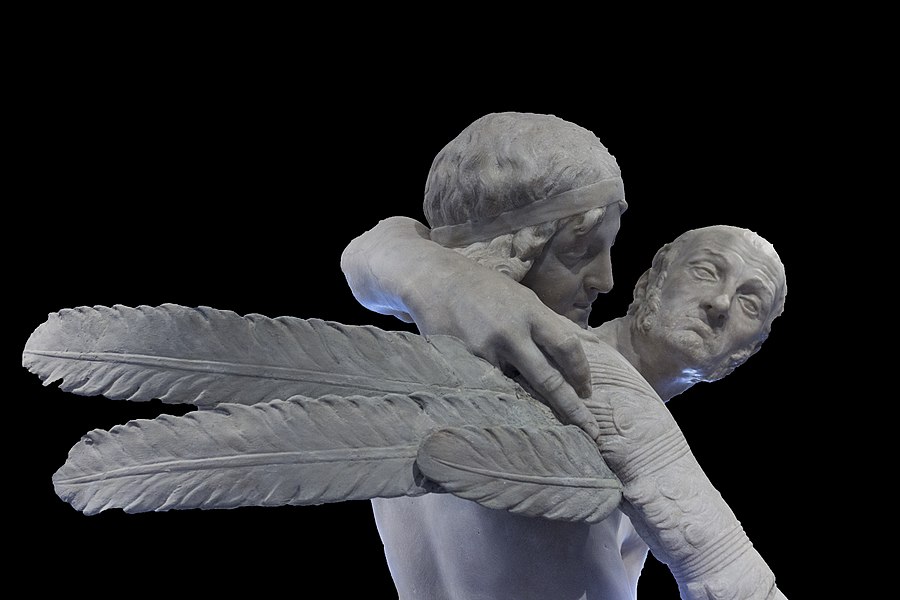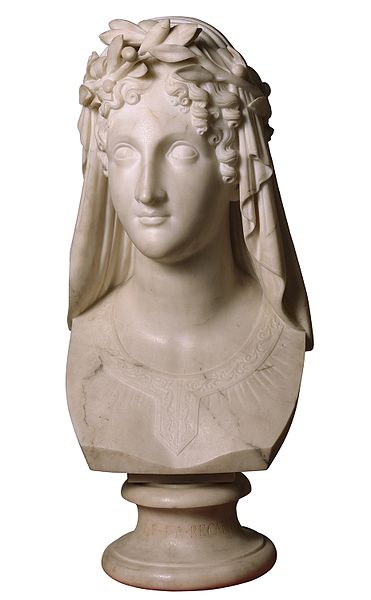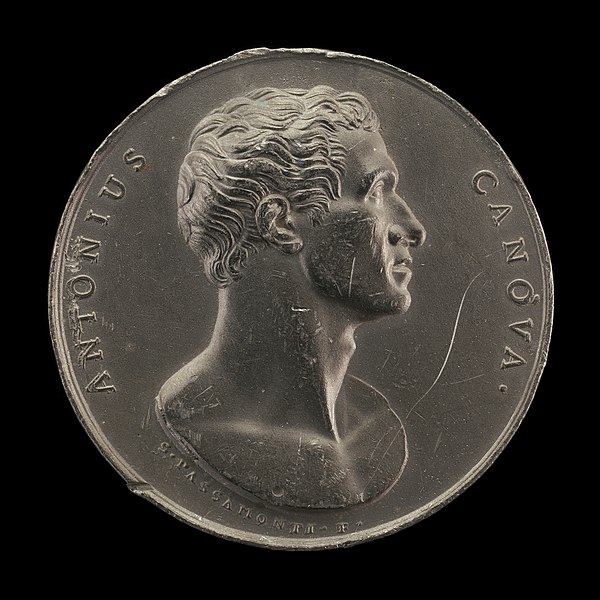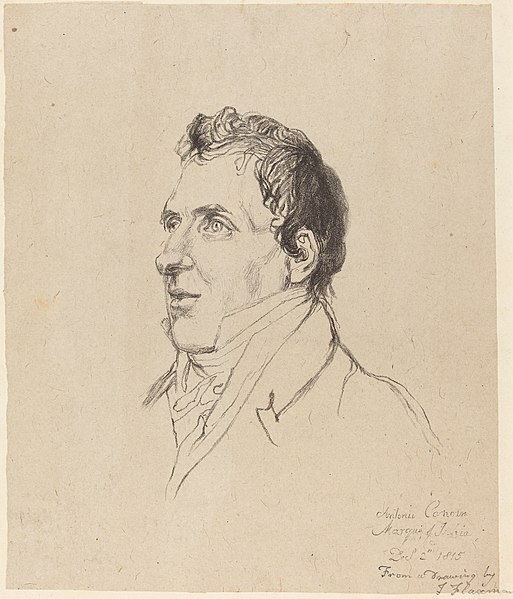 1
1title: 'Terpsichore Lyran (Muse of Lyric Poetry)'
artist: antonio canova
date: Sculpture created in 1816; photograph taken in July 2008.
medium: Technique marble sculpture
dimensions: size cm 177.5 78.1 61
current location: Institution:Cleveland Museum of Art
source: Sculptor antonio canova (1757-1822); I took this photograph.
credit: Sculptor antonio canova (1757-1822); I took this photograph.
description: Terpsichore, created 1816 by antonio canova (1757-1822), in the Cleveland Museum of Art, Cleveland, Ohio, USA. There were no prohibitions against photography in the museum. I took this photograph.
license:Public domain
2
title: D'après Thomas Lawrence Antonio Canova
artist: Thomas Lawrence
date: 19th century
medium: oil on canvas
dimensions: Size unit=m width=0.71 height=0.91
current location: Sully, floor|2 , Donation Hélène et Victor Lyon, room|C Museum:Louvre
source: u|Sammyday (2010-10-23)
credit: Sammyday (2010-10-23)
license:Public domain
 3
3title: Artgate Fondazione Cariplo Canova Antonio, Allegoria della Giustizia
artist: antonio canova
date: 1792
medium: technique gypsum
dimensions: Size unit=cm height=129 width=129
current location: Institution:Gallerie di Piazza Scala it|Sezione I
source: [link Artgate Fondazione Cariplo]
credit: Artgate Fondazione Cariplo
description:
The bas-relief of the Goddess of Justice is part of a group of thirteen plaster casts – representing allegorical figures, scenes inspired by the Iliad, the Odyssey and Phaedo, and depicting two works of mercy – in the Foundation’s Congress Centre. The reliefs were executed by canova as a gift for Abbondio Rezzonico, a member of the Roman Senate, between 1793 and 1795. Rezzonico had already commissioned from the sculptor the commemorative monument to his uncle Pope Clement XIII, which was erected in St. Peter’s but not unveiled until 1792, twenty-three years after the Pope’s death. In 1781, the Veneto artist had executed for the Senator the statuette Apollo Crowning Himself now held by the Getty Museum in Los Angeles. Evidently the two men were on very friendly terms, probably also because they were both from the Veneto region. A frequenter of Rome artistic circles, Rezzonico also commissioned works from Piranesi and Pompeo Batoni – who immortalised him in a portrait now in the Museo di Bassano del Grappa. The bas-reliefs were hung in Villa Rezzonico at Bassano to create a “Canovian room”, as attested by 19th-century sources, similar to those in other aristocratic residences in Veneto (those of Zulian, Renier, Falier, Albrizi, Barisan, Cappello) as well as Rome (Villa Lante, Villa Torlonia). There is evidence that in the course of his career canova produced various series of bas-reliefs, sometimes with different subjects, to satisfy the demands of collectors who kept up with all the current artistic trends. The most complete series of plaster casts, which were never executed in marble, is in the Gipsoteca in Possagno, and another series very like the one in the Cariplo Collection, is located in the Museo Correr, Venice.
The technique used to execute them was the lost wax process, which enables a one-off piece to be produced from a cast obtained from a prototype: this allows the artist to work on the plaster and to give it a unique quality. We know that canova was in the habit of emphasising this original aspect also to justify the cost of producing the pieces, although he delegated the actual production to talented assistants like Vincenzo Malpieri.
The desire to promote his own work led canova, spurred on by the intellectuals of the day such as Pietro Giordani and Francesco Leopoldo Cicognara, to reproduce his sculptures in engravings, in order to make his production more widely known through an economical, straightforward medium. The collection of prints dedicated to “Connoisseurs and Lovers of Fine Arts”, published by the Rome bookseller Pier Luigi Scheri in 1817, is one of the finest examples of this, and the sculptor invited some of the leading artists then active in Rome, including Vincenzo Camuccini, Raffaello Morghen, Jean-Baptiste Wicar, Tommaso Minardi and Francesco Hayez, to work on the project.
Engravings of most of the plaster reliefs were executed, with the exception of the three Allegories connected with the design for Clement XIII’s tomb.
The story of the Rezzonico reliefs is documented in the writings of the Rome antiquarian Giovanni Gherardo de Rossi: in 1793 canova antonio, Allegoria della Speranza.jpg">Hope and canova antonio, Allegoria della Carità.jpg">Charity, casts made from the figures sculpted on Clement XIII’s sarcophagus, were delivered; canova antonio, Briseide consegnata da Achille agli araldi di Agamennone.jpg">Achilles Delivers Briseis to Agamemnon’s Heralds, canova antonio, Uccisione di Priamo.jpg">Death of Priam and canova antonio, Socrate beve la cicuta.jpg">Socrates Drinking Hemlock can be dated to the same year; and canova antonio, Socrate congeda la propria famiglia.jpg">Socrates Taking Leave of His Family, canova antonio, Danza dei figli di Alcinoo.jpg">Dance of the Sons of Alcynous and canova antonio, Ritorno di Telemaco.jpg">Return of Telemachus and canova antonio, Allegoria della Giustizia.jpg">Justice, to 1794. The latter is the most interesting piece in the group, since it is the artist’s original study – and therefore not featured in other series – for a figure that does not appear in the final version of the funerary monument completed between 1784 and 1792. Lastly, canova antonio, Critone chiude gli occhi a Socrate.jpg">Crito Closing the Eyes of Socrates and canova antonio, Offerta del peplo a Pallade.jpg">Hecuba Offering the Robe to Pallas arrived in Bassano del Grappa in 1795. To the same year should be dated canova antonio, Dar da mangiare agli affamati.jpg">Feed the Hungry and canova antonio, Insegnare agli ignoranti.jpg">Teach the Ignorant, possibly executed on Rezzonico’s wishes, since he placed them in a school for children established on the premises of his villa.
In all probability, and with the exception of the two pieces depicting works of mercy, the idea for the prototypes was developed some years earlier, as stated in canova’s biography in Bassano: in point of fact they were executed at the same time as the funerary monument to Clement XIII, between 1783 and 1792. The technique of the plaster relief enabled canova to experiment with a new language that was wholly Neoclassical and thus devoid of decorative elements and strict rules of perspective. These works reveal the sculptor’s attempt to adapt to contemporary literary canons, using a style that was spare and dramatic to the point of being expressionistic.
The bas-reliefs stayed in Bassano until 1837, when they were sold to the collector antonio Piazza, who hung them in his mansion in Padua, which was later bought by the Counts of San Bonifacio. From there they went, as part of an inheritance, to a country house on the Verona plain, and were purchased by the Cassa di Risparmio delle Provincie Lombarde in 1991.license:
CC BY-SA 3.0
4
title: François Gérard Antonio Canova en 1802
artist: François Gérard
date: 1802
medium: oil on canvas
dimensions: Size unit=m width=0.54 height=0.65
current location: Sully - 2 e étage - David et ses élèves - Salle 54 Museum:Louvre
source: u|MOSSOT (2012-03-30)
credit: MOSSOT (2012-03-30)
description: Portrait d'antonio canova peint en 1802 et présenté au Salon de 1808.
license:Public domain
 5
5title: Antonio Canova Dedalo e Icaro
artist: antonio canova
date: between 1777 and 1779
medium: Technique marble
current location: Institution:Museo Correr, Venice
source: User:JeanBono/Credit
credit:

This picture belongs to Xavier Caré. Please credit : Xavier Caré / Wikimedia Commons / CC-BY-SA.
If you would like special permission to use, license, or purchase the image please contact me to negotiate terms.
I'd appreciate if you could let me know about it or mail me (
 xavier
xavier famillecare.fr.eu.org) if you want to use this picture out of the Wikimedia project scope.
famillecare.fr.eu.org) if you want to use this picture out of the Wikimedia project scope.
description: Dédale et Icare, par antonio canova, exposé au Musée Correr de Venise en 2017.
license:
CC BY-SA 4.0
 6
6title: Canova Antonio Juliette Récamier en Béatrice
artist: antonio canova
date: between 1818 and 1822
medium: Buste en marbre
current location: Institution:Musée des Beaux-Arts de Lyon
source: Œuvre appartenant au [[Musée des Beaux-Arts de Lyon]] Photographe Alain Basset
credit: Œuvre appartenant au Musée des Beaux-Arts de Lyon Photographe Alain Basset
license:
CC BY-SA 4.0
 7
7title: Antonio Canova, after the Antique, Winged Victory, c. 1803 1806, NGA 73399
artist: antonio canova, after the Antique
date: c. 1803/1806
medium: bronze
dimensions: overall (with base): 76.6 x 20 x 18.1 cm (30 3/16 x 7 7/8 x 7 1/8 in.) gilded globe (diameter): 10.2 cm (4 in.) overall (figure height from left big toe to top of head): 38 cm (14 15/16 in.) overall (figure height from left big toe to right wing tip): 53.3 cm (21 in.) overall (figure height from left big toe to left wing tip): 51.8 cm (20 3/8 in.) base (height): 14.9 cm (5 7/8 in.)
current location: Institution:National Gallery of Art
source: link Template:NGADC
credit: This file was donated to Wikimedia Commons as part of a project by the National Gallery of Art. Please see the Gallery's Open Access Policy.
license:
CC0
 8
8title: Antonio Canova, Dancer with Finger on Chin, model 1809 1814, carved 1819-1823, NGA 127590
artist: antonio canova
date: model 1809/1814, carved 1819/1823
medium: marble
dimensions: overall (approximate height): 177 cm (69 11/16 in.) weight, with attached base: 724 lbs
current location: Institution:National Gallery of Art
source: link Template:NGADC
credit: This file was donated to Wikimedia Commons as part of a project by the National Gallery of Art. Please see the Gallery's Open Access Policy.
license:
CC0
 9
9title: Stefano Passamonti, Antonio Canova, 1757 1822, Sculptor (obverse), 1816, NGA 117810
artist:
Stefano Passamontidate: 1816
medium: lead
dimensions: overall (diameter): 6.81 cm (2 11/16 in.) gross weight: 178.22 gr (0.393 lb.) axis: 12:00
current location: Institution:National Gallery of Art
source: link Template:NGADC
credit: This file was donated to Wikimedia Commons as part of a project by the National Gallery of Art. Please see the Gallery's Open Access Policy.
license:
CC0

title: After John Flaxman, Antonio Canova, 19th century, NGA 59471
artist:
after John Flaxmandate: 19th century
medium: lithograph on papier colle
current location: Institution:National Gallery of Art
source: link Template:NGADC
credit: This file was donated to Wikimedia Commons as part of a project by the National Gallery of Art. Please see the Gallery's Open Access Policy.
license:
CC0





